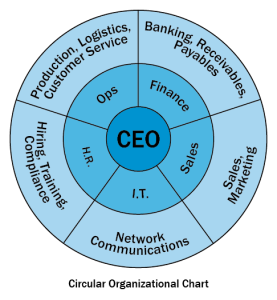Business owners are accustomed to wearing many hats, and many don’t have the financial resources or personnel to field a full management team. The owner winds up wearing one or more functional hats in addition to that of the CEO.
If you have managers in several areas, one usually assumes the mantle of Second-in-Command (SIC). He or she provides leadership in your absence, and assumes decision making responsibility. Whether that person is a true SIC depends on how many roles he or she can fill when needed.
 This is a circular organizational chart. It’s a different way of looking at the management responsibilities in your company. In the second circle, outside the CEO, are the functional areas of running the business. You company may combine a few (like finance and HR), or have one or two more (such as R&D.) The point is to illustrate that the responsibility for day to day supervision and direction gravitates to the center. Each functional area that isn’t assigned to a specific manager becomes the CEO’s by default.
This is a circular organizational chart. It’s a different way of looking at the management responsibilities in your company. In the second circle, outside the CEO, are the functional areas of running the business. You company may combine a few (like finance and HR), or have one or two more (such as R&D.) The point is to illustrate that the responsibility for day to day supervision and direction gravitates to the center. Each functional area that isn’t assigned to a specific manager becomes the CEO’s by default.
The more that you spend your time in a functional area, the less time you have to be CEO. Just as important, if you are working full time in one or more areas (sales, operations) then it is unlikely that you have any time to back up the others if an employee leaves or is incapacitated.
Most small business owners, especially founders of companies, are utility infielders. They began by doing everything, and can still handle most functions when necessary. That isn’t unexpected, and it is often necessary to be every manager’s backup.
Further, businesses with less than 50 employees usually can’t afford a President; someone who serves as the first option to cover every functional position, and who leaves the CEO to full-time CEO duties. Until you reach that level, one of the functional managers in the second circle has to serve as your SIC.
Determining whether you have a real Second-in-Command starts with discussing who bears responsibility for gaps in other functional areas. Too often the CEO has one (in this chart lets take sales) and the presumed SIC (a Controller in Finance, for example) another. The unspoken assumption is usually that a vacancy in any other area automatically becomes the CEO’s. The so-called SIC is unwilling or incapable of stepping in anywhere but his or her own specific area of responsibility.
That isn’t a Second-in-Command. That’s a manager who is merely first among equals. Being the CEO is a real job. It can’t just be shunted aside every time there is an operational need. There should be clear delineation between the two of you as to which roles each is expected to back up. Until you have a key manager who specifically understands that covering other areas of management when needed is a part of the job, you will remain your own Second In Command.
